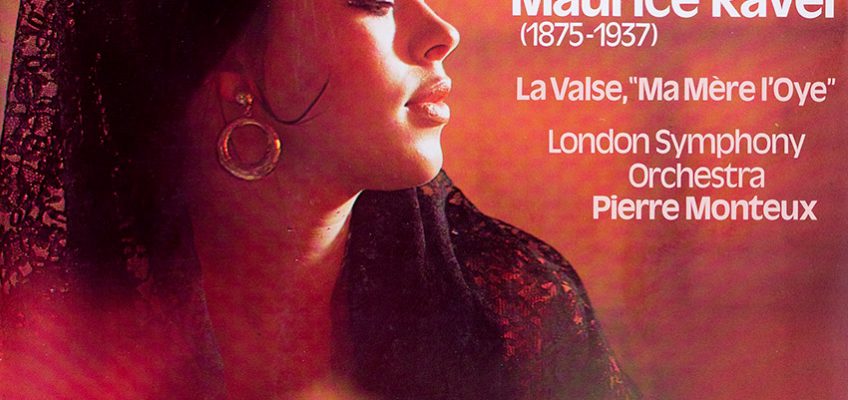Sleeve Notes:
Maurice Ravel was born on March 7, 1875, in Cibourne in the French Pyrenees. His family moved to Paris after his birth and, in 1889, he began study at the Conservatoire with Beriot (piano), Gedalge (counterpoint), and Faure (composition). He competed three times for the .Prix de Rome without success; a scandal ensued the fourth time when he was denied the right to participate in the competition — he had chosen to write a cantata in the style of an operetta. Moreover, many of his early performed works were ill-received.
Musically Ravel was highly influenced by Faure, Chabrier, and the “Five” of the Russian school, but he also felt himself drawn to modern composers like Stravinsky, whom he knew personally.
“Bolero”
Towards the end of 1929, Ravel was asked to orchestrate the “Iberia” piano suite by Albeniz for Ida Fiubinstein’s guest performance at the Paris Opera. When he later learned that Enrique Arb6s had secured all rights for the work, he decided to write a new composition, although Arb6s had in the meantime agreed to waive his rights. Ravel avoided compositional difficulties by limiting himself to two characteristic Spanish dance themes which repeated themselves constantly, without any real development, in a long continuous crescendo. The successful premiere of the ballet took place on November 20, 1928.
“Ma Mere l’Oye”
Ravel loved children. His fairy-tale suite, “Ma Mere l’Oye” (Mother Goose) was originally composed as a piano duet for the children of his friends the Godebskis — Mimi and Jean. Four years later, in 1912, the five movements of the suite were rewritten as a ballet. The music is marked by a motivic simplicity, incorporating the traditional fairy-tale characters.
Even groomed for adult occasions, the work has not lost its innocence. We expect it at any moment to say something naively horrid but it is well-bred and never does. The 20 diatonic bars of the “Pavane of the Sleeping Beauty” are dignified and gracious in the trim rise and fall of their phrases.
In “Petit Poucet” a slight-social difficulty occurs as Hop-o’-my-Thumb, unable to find his way back by means of the bread-crumbs he had dropped to mark the trail (the birds, naturally, had eaten them all up)announces his panic first by two beats in the bar, then by three, and so on up to five. He is left bangjng doubtfully off the end of the music, partially consoled, it may be,
by memories of the waltz theme from “Beauty and the Beast,” or by anticipation of the dainty freshness of the “Empress of the Pagodas,” who, to the strains of a melody played entirely on the black keys in the piano version, proceeds to take her bath in the garden. After an interlude “The Fairy Garden” wakes up slowly in serene four-part writing before, at last, a little tolling bell makes us rub our eyes to meet reality once more.
“La Valse”
“La Valse” (1923) was created initially as a “choreographic poem” which paid homage to the waltz capital in its original title “Vienna.” Diaghilev expressed his willingness to present the work as a ballet but subsequently withdrew the offer. The final stage version was by Ida Rubinstein. While “La Valse” is primarily a Viennese waltz, an atmosphere of melancholy takes the place of the usual frivolity. The score carries the following inscription: “Drifting clouds give glimpses, through rifts, of couples waltzing. The clouds gradually scatter, and an immense hall can be seen, filled with a whirling crowd. The scene gradually becomes illuminated. The light of chandeliers bursts forth. An imperial court about 1855…”
Pierre Monteux
Like Ravel Pierre Monteux was born in 1875. He became famous as the conductor of Diaghilev’s “Ballet russe” and conducted the premieres of Ravel’s “Daphnis et Chloe” and Stravinsky’s “Petrouchka” and “Le sacra du printemps.” From 1917 to 1919 he conducted the Metropolitan Opera in New York before taking overthe Boston Symphony Orchestra. He was second conductor with the Concertgebouw Orchestra, Amsterdam, from 1924 to 1934. In 1929 he founded the Orchestra Symphonique de Paris and directed it in a series of famous concerts until 1938. Meanwhile, in 1936, he had become director of the San Francisco Symphony Orchestra which he conducted until 1952. From 1961 until his death in 1964 he was chief conductor of the London Symphony Orchestra.

Label: Philips 6580 106
1964 1960s Covers
Cover photograph:@ Dick Horsman

